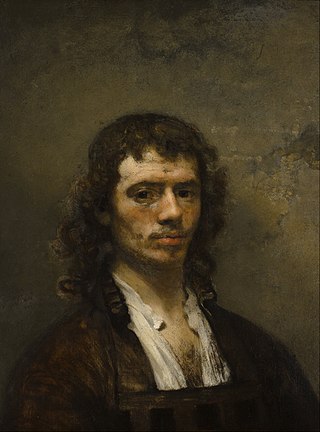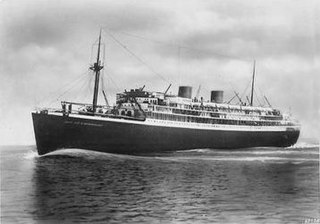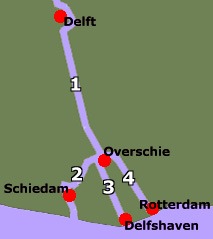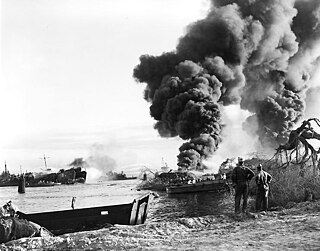
Delft is a city and municipality in the province of South Holland, Netherlands. It is located between Rotterdam, to the southeast, and The Hague, to the northwest. Together with them, it is a part of both the Rotterdam–The Hague metropolitan area and the Randstad.

Delftware or Delft pottery, also known as Delft Blue or as delf, is a general term now used for Dutch tin-glazed earthenware, a form of faience. Most of it is blue and white pottery, and the city of Delft in the Netherlands was the major centre of production, but the term covers wares with other colours, and made elsewhere. It is also used for similar pottery, English delftware.

Carel Pietersz. Fabritius was a Dutch painter. He was a pupil of Rembrandt and worked in his studio in Amsterdam. Fabritius, who was a member of the Delft School, developed his own artistic style and experimented with perspective and lighting. Among his works are A View of Delft, The Goldfinch (1654), and The Sentry (1654).
Cooking off is unfired weapon ammunition exploding prematurely due to heat in the surrounding environment. The term is used both for detonation of ammunition not loaded into a weapon, and unintended firing of a loaded weapon due to heating.

TSMS Lakonia was an ocean liner that was launched in 1929 for Netherland Line as the ocean liner Johan van Oldenbarnevelt. In 1962 she became the Greek Line cruise ship TSMS Lakonia. On 22 December 1963 she caught fire at sea and on 29 December she sank. 128 people were killed in the disaster.
There have been many extremely large explosions, accidental and intentional, caused by modern high explosives, boiling liquid expanding vapour explosions (BLEVEs), older explosives such as gunpowder, volatile petroleum-based fuels such as gasoline, and other chemical reactions. This list contains the largest known examples, sorted by date. An unambiguous ranking in order of severity is not possible; a 1994 study by historian Jay White of 130 large explosions suggested that they need to be ranked by an overall effect of power, quantity, radius, loss of life and property destruction, but concluded that such rankings are difficult to assess.
Naval artillery in the Age of Sail encompasses the period of roughly 1571–1862: when large, sail-powered wooden naval warships dominated the high seas, mounting a large variety of types and sizes of cannon as their main armament. By modern standards, these cannon were extremely inefficient, difficult to load, and short ranged. These characteristics, along with the handling and seamanship of the ships that mounted them, defined the environment in which the naval tactics in the Age of Sail developed.

The Studentenstam De Delftsche Zwervers is a student society in Delft, Netherlands. Dating from 1915, it is the world's oldest student Scouting group, first as a club for former Scouts, from 1920 as a Rover crew. They are housed in the Scout Centre "Kruithuis", the monumental gunpowder ammunition dump of the Dutch Republic, designed in 1660 by Pieter Post. The members are students at the Delft University of Technology and other higher education institutions.

A gunpowder magazine is a magazine (building) designed to store the explosive gunpowder in wooden barrels for safety. Gunpowder, until superseded, was a universal explosive used in the military and for civil engineering: both applications required storage magazines. Most magazines were purely functional and tended to be in remote and secure locations. They are the successor to the earlier powder towers and powder houses.

The Battle of Flamborough Head was a naval battle that took place on 23 September 1779 in the North Sea off the coast of Yorkshire between a combined Franco-American squadron, led by Continental Navy officer John Paul Jones, and two British escort vessels protecting a large merchant convoy. It became one of the most celebrated naval actions of the war in America, despite its relatively small size and a considerable dispute over what had actually occurred.
Gracht is a Dutch word for a canal within a city. Grachten often have a round shape, and form a circle around the city cores in the Netherlands, Belgium, and northern Germany. Outside the Netherlands, the word grachten mostly refers to the city canals of Amsterdam and also Utrecht, Leiden and The Hague. The Koninginnegracht in The Hague was conceived by King Willem I for the promotion of tourism in the early 19th century. Since 2009 the Willemsvaart once more offers tours over this gracht, to Scheveningen, known as "StrandRelax" or "BeachRelax", a unique stretch of sand between The Hague and the sea.

Schie the name for four waterways in the area of Overschie, South Holland, the Netherlands. There are the Delftse Schie, the Delfshavense Schie, the Rotterdamse Schie and the Schiedamse Schie. The existence of these four streams is the result of medieval rivalry among the cities of Delft, Rotterdam, and Schiedam for toll rights.

The West Loch Disaster was a maritime accident during World War II at Pearl Harbor U.S. Naval Base in Hawaii. The incident, which occurred just after 3 p.m. on Sunday, 21 May 1944, began following an explosion in a staging area for Landing Ships, Tank (LSTs) and other amphibious assault ships in West Loch. A fire quickly spread among the ships being prepared for Operation Forager, the invasion of the Japanese-held Mariana Islands. Over the next 24 hours, six LSTs sank, 163 naval personnel died, and 396 were injured.

View of Delft is an oil painting by Johannes Vermeer, painted c. 1659–1661. The painting of the Dutch artist's hometown is among his best known. It is one of three known paintings of Delft by Vermeer, along with The Little Street and the lost painting House Standing in Delft, and his only cityscape. According to art historian Emma Barker, cityscapes across water, which were popular in the Netherlands at the time, celebrated the city and its trade. Vermeer's View of Delft has been held in the Dutch Royal Cabinet of Paintings at the Mauritshuis in The Hague since its establishment in 1822.
The Dublin gunpowder explosion was a large explosion that took place on the quays of Dublin on 11 March 1597. The explosion demolished as many as forty houses, and left dozens of others badly damaged. The explosion claimed the lives of 126 people and inflicted countless injuries.

Carel Lodewijk Hansen, was a 19th-century painter from the Netherlands.

The Wassenaar was a Dutch 64-gun third rate ship of the line of the navy of the Dutch Republic and the Batavian Republic, and the Royal Navy. The order to construct the ship was given by the Admiralty of the Meuse. The ship was commissioned in 1781. In 1783/1784, the Wassenaar sailed to Batavia under Captain Gerardus Oorthuis.
The Lioness was a steamboat that exploded on the Red River of the South on the morning of May 19, 1833.
Royal Charlotte was launched by Bombay Dockyard in 1774 as a country ship. She made one voyage for the British East India Company in 1796 when she sailed from Calcutta to Britain. There she took on British registry. She sailed back to Calcutta where a lightning bolt ignited her magazine, destroying her in 1797.












